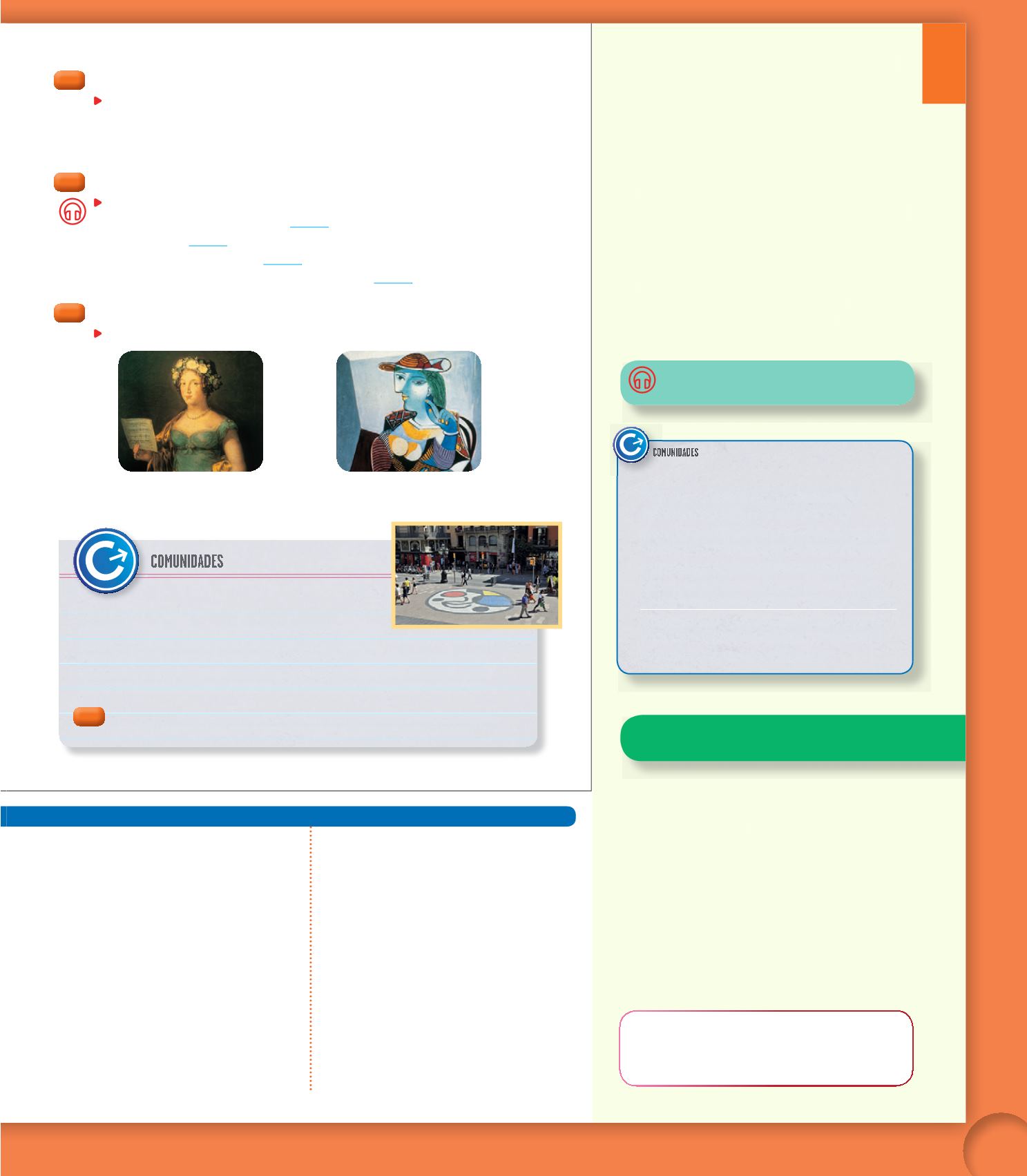

77
Activities
18.
Before playing the recording, have students
read each statement and determine the type of
comparison that is being made. Then ask them
to complete the statements and check their
answers after listening to the dialogue.
19.
Ask students to compare and contrast the
colors, perspective, shapes, volume,
background, foreground, and style.
AUDIO SCRIPT
See page 297K.
Answer Key
16.
This painter is more creative than that one.
The painter created a nicer painting than he
was hoping for.
17.
1. que
2. de lo que
3. que
18.
1. de las que
3. de la que
2. de lo que
4. como
19.
Answers will vary.
20.
Answers will vary.
Gramática – Las comparaciones
DESAFÍO 1
Unit
6
1
8
¿Más o menos?
Escucha
los diálogos y completa estas afirmaciones.
1.
En el Museo del Prado hay más obras
pensaba Ethan.
2.
Botero es mayor
creía Eva.
3.
Eva y Ethan tienen más pintura
necesitan.
4.
Eva tiene tantas ganas de viajar a la Ciudad de México
Ethan.
1
9
Compara las obras
Escribe
con tu compañero(a) ocho oraciones comparando estos cuadros.
El arte en la calle
La gran riqueza artística y cultural del mundo hispano se puede
apreciar en sus calles, donde hay verdaderas obras de arte. Por
ejemplo, el mural que retrata la historia azteca en la pared exterior de la biblioteca de
la Universidad Nacional Autónoma de México, el mosaico de Joan Miró en Las Ramblas
de Barcelona o el Parque de las Esculturas de Medellín, con obras de Fernando Botero.
0
2
Compara.
¿Hay arte en los espacios públicos de tu comunidad? ¿Qué ventajas
y desventajas tiene exponer el arte en la calle en vez de hacerlo en museos?
Mosaico de Joan Miró (Barcelona).
Francisco de Goya.
La duquesa
de Abrantes
(1816).
Pablo Picasso.
Retrato de Marie-
Thérèse
(1937).
1
7
Comparaciones
Elige
la opción correcta y escribe oraciones completas.
1.
Las pinceladas de Van Gogh son menos precisas
(que/de lo que/como)
las de Botero.
2.
Este cuadro es mucho más grande
(que/de lo que/de los que)
pensaba.
3.
Pienso que Picasso era igual de talentoso
(que/de lo que/como)
Velázquez.
HERITAGE LANGUAGE LEARNERS
r
Explain to students that many years ago,
portraits served the same purpose as our
photographs today. They are records of
people, places, pets, things, and events that
have had an impact on our lives. Ask
students what or whom they would paint if
they were artists. Have them name a family
member, a friend, or someone in the news,
as well as an event or place that has had
an influence on them. Students should
be prepared to explain why this person,
place, thing, or event is worthy of their
artistic talent.
COOPERATIVE LEARNING
r
Ask students to imagine that they work for
their local government and want to promote
art in public places throughout their
community. Working in small groups, have
students come up with the best plan for
exhibiting this kind of art. Group members
will need to figure out the kind of art they
want to promote. They will also need to
establish whether there will be permanent
exhibits, or seasonal ones. They may
consider a theme for the art, and any
lectures to accompany the exhibits. Call on
groups to explain their plans to the class.
Additional Resources
Fans Online activities
Practice Workbook
El arte en la calle
Many people believe that it is important
to add beauty to cities and to create a
connection between the people, their culture,
and their environment. And in many cities of
the Spanish-speaking world, one does not
need to go to a museum to see art. Just by
walking through a plaza, park, or street, public
art can be admired. For instance, in the city
of Caracas, Venezuela, there are more than
400 works of art in public spaces.
309
Book 4 Unit 6


















